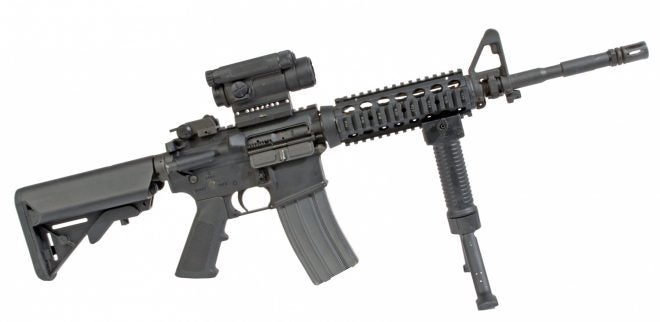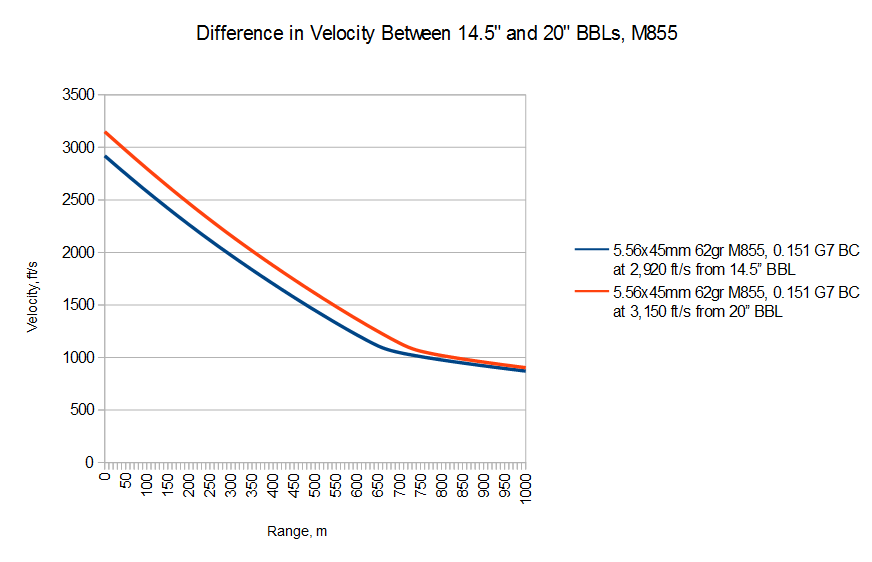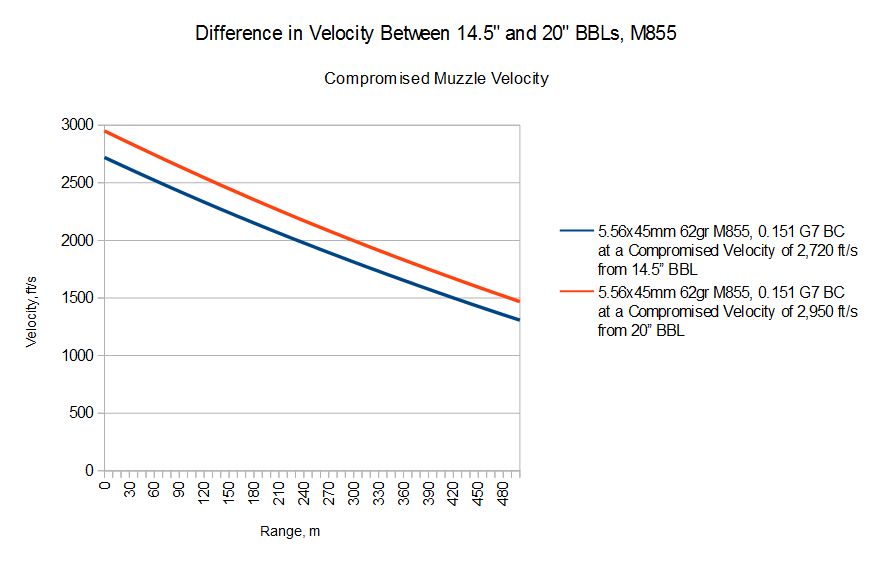In my comments section recently, I was asked to shed some light on the velocity penalty created by moving from 20″ long rifle barrels as in the M16 to 14.5″ long carbine barrels as in the M4 Carbine. Our readers’ wish is my command, and so here we are.
In the very first edition of the Modern Intermediate Calibers series, I talked about the 5.56x45mm and its performance from both 14.5″ and 20″ barrels. However, the graphs produced for that post lack the clarity we’d like to discuss this issue in detail, partly because they are a little crowded, and partly because I hadn’t quite balanced them for clarity and size yet. So, to begin answering this question, let’s take another look at that data, only this time we’re going to clear out the other loads and just focus on M855 from 14.5″ and 20″ barrels:
Looking at just the velocity curves for a moment, how do we interpret this data? Well, one of the primary criticisms of the M4 focuses on the fragmentation threshold of the Carbine versus its longer, older brother. Critics say that while the M16 has an adequate fragmentation threshold for normal combat, the M4 – due to its lower muzzle velocity – has a much shorter fragmentation threshold.
However, this talk to fragmentation thresholds is too simplistic, at least when talking about M855 (M855A1, due to its more consistent fragmentation properties, is a better candidate for this metric). Still, fragmentation thresholds are really a subject for another day, so for now let’s take it for granted, and compare the two curves. Before we continue, let’s lay out our assumptions:
1. M855 will produce 2,920 ft/s from the 14.5″ barrel of an M4 Carbine.*
2. M855 will produces 3,150 ft/s from the 20″ barrel of an M16A2 Rifle.*
3. Out to the distances we care about, the velocity curve given by the 0.151 G7 BC figure accurately represents the real-world velocity curve of M855, under standard conditions.
4. For convenience, we will assume a fragmentation “threshold” of 2,500 ft/s, even though this subject deserves a much more in-depth treatment, which we will reserve for another day.
Alright, so where does the data get us?
From the data, the M4 Carbine with its 14.5″ barrel and 2,920 ft/s muzzle velocity meets our velocity threshold at 125 meters, while the M16A2 with its 20″ barrel and 3,150 ft/s muzzle velocity meets the threshold at 190 meters.
In other words, the difference in velocity between the two rifles is enough to create a “gap” in performance of 65 meters, or put differently, the M16A2 has by this model a 52% fragmentation range advantage versus the M4.
These numbers are nice, but immediately we should understand that this model has some serious limitations due to its four assumptions. We’ll worry about assumption 3 another day, but let’s take a look at assumptions 1 and 2 for a moment. Do these velocity figures represent the actual muzzle velocities produced by service rifles and carbines, and if these figures are changed, how does that affect the end result? I would characterize these figures as being “nominal” for both weapons, which means that I would expect a brand new rifle of either type firing in-spec ammunition made by an American manufacturer to produce velocities close to these figures. Or, put another way, these are “high” figures that represent the maximum muzzle velocity produced by either type of rifle assuming no errors in quality control and a temperate environment.
What if we don’t have these things? What if our rifles are worn out, or our ammunition was “cooler” because it came from a manufacturer that didn’t load so hot as IWI or Winchester, or what if it’s just damn cold out? Well, we have a good idea how these things affect the weapon, for two reasons. First, because barrel life in the context of ammunition testing is defined by a velocity drop of 200 ft/s or greater, over the course of usually 10,000 or 15,000 rounds. Second, we have a very good test from Small Arms Defense Journal written by Dr. Philip H. Dater & Jason Wong, which chilled the ammunition for consistency reasons before testing commenced. From a 14″ barrel, their chilled M855 ammunition gave them muzzle velocities about 200 feet per second below our nominal M4 muzzle velocity above.
Therefore, it stands to reason that some weapons in service will – due to any one or combination of these factors of cold, barrel wear, and ammunition “hotness” – produce muzzle velocities as low as 200 ft/s below the numbers quoted above. This makes our next step pretty clear:
In this situation, the difference becomes more pronounced. The M16A2 with a compromised muzzle velocity gives us just a shade more fragmentation range than the fresh M4 under ideal conditions – 133 meters – while the M4 with a compromised muzzle velocity gives a very disappointing fragmentation threshold of 66 meters. This means that in these less than ideal conditions, the M16A2 has a 67 meter – or 101% – advantage versus the M4.
Before I leave you there, let’s briefly challenge assumption 4 by changing focus from M855 to the new M855A1 round. We’ve already noted that the entire concept of a “fragmentation threshold” is overly simplistic and really deserves its own post, but one wrench we can throw into the gears right now is that we know Enhanced Performance Rounds like M855A1 seem to have much lower fragmentation thresholds than their predecessors. We have seen that M80A1, M855A1’s 7.62mm counterpart, can fragment very violently at velocities as low as 1,930 ft/s. Therefore, our “2,500 ft/s” value is likely far too high for these rounds, and not at all representative.
Fortunately, M855A1 has a close enough ballistic value to M855 over the distances we are considering that we can simply take the data we’ve got and stack it up against a different fragmentation threshold value, let’s say, 1,900 ft/s. If we do that:
M16A2 (V0 3,150 ft/s): 391 m
M4 (V0 2,920 ft/s): 326 m
M16A2 (V0 2,950 ft/s): 335 m
M4 (V0 2,720 ft/s): 268 m
Immediately, we see that by changing our assumption for fragmentation threshold velocity, the entire ball game changes. Without questioning these thresholds for the time being, we see that a velocity-compromised M4 loaded with M855A1 has a 78 meter (41%) fragmentation range advantage over a brand new M16A2 loaded with hot M855 and fired under ideal conditions. The ideal M16A2 loaded with M855A1 enjoys a full 201 meter (106%) advantage over its counterpart loaded with M855.
So, in the end, what do we make of this? Well, it’s tough, and the only basic conclusions we can come to are “it’s complicated”, and “the M16 generally enjoys an advantage over the M4”. However, the most obvious conclusion is that if a longer fragmentation range is desired, the right answer is not a longer barrel, but a bullet that fragments at a lower velocity. Something, it seems, the Army has already realized.
 Your Privacy Choices
Your Privacy Choices


